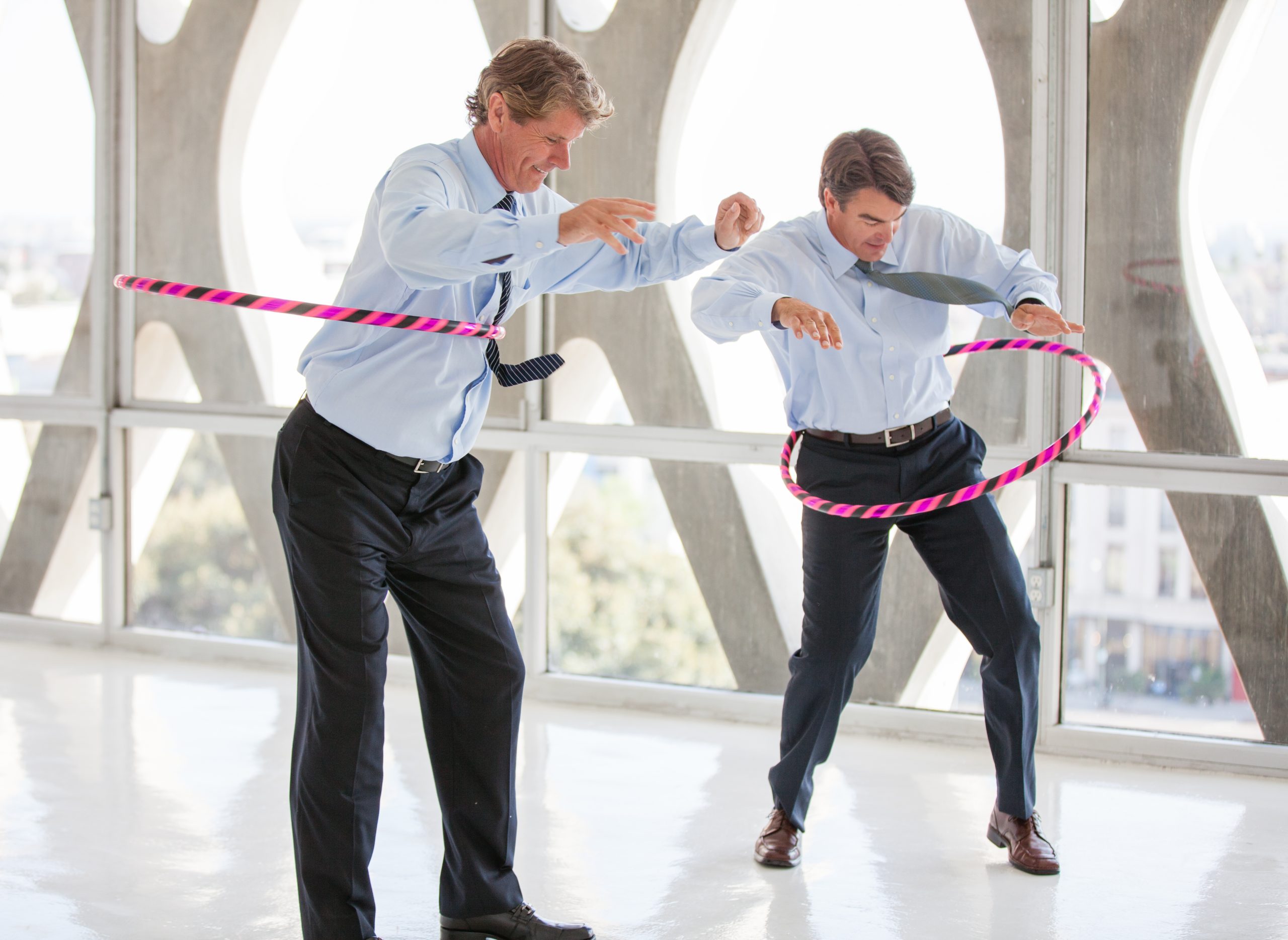
*This is an article from the Summer 2022 issue of Contentment Magazine.
By Laura Putnam, author of Workplace Wellness that Works and CEO of Motion Infusion.
During a layover on a business trip, I stopped for lunch at the airport Chili’s, sidling up to the bar. The woman next to me was another solo business traveler, and after the usual “What do you do?” conversation starter, I mentioned that I was a workplace wellness entrepreneur. She cocked her head and visibly exhaled. “Yeah, I started doing those walking meetings with my team.” Judging by her tone and her body language, it was clear that doing so was definitely outside of her comfort zone. Perhaps, I surmised, walking meetings had become “de jour” within her company, and maybe she felt she needed to follow along with company trends. “I thought I would try it out during my one-on-ones,” and a key component to initiating this new way of meeting, she explained, was allowing each of her team members to take the lead on how the walking meeting played out. Some opted for a brisk walk while others picked out the nearest bench. “Any of these options were fine by me,” she explained.
Then, she leaned in. “But you know the most amazing thing happened out of these,” and she paused. “You see, I had been trying to get each of my team members to be more open to coaching. However, I wanted them to ask for it. I didn’t want to force it on them, and for years, they resisted it. None of them ever asked for it.” That is – until she switched up the one-on-ones into walking meetings. “Suddenly, each member approached me separately and said, ‘You know that coaching? I think I’m ready for it now.’ It was like a magic serum. Those walking meetings just opened people up in a way they hadn’t beforehand.”

Businessmen And Businesswomen Dancing In Office Lobby
Fast forward to where we are today. Every organization, team, and individual must reckon with the effects of the pandemic, which will likely be impacting us for years to come. The spike in diabetes, the toll on our mental health including a notable rise in rates of burnout, the awakening to the depth of structural inequities that continue to plague our society and institutions, and the vast numbers of employees leaving their jobs are just a few examples of how the pandemic continues to play out in our lives. Each of these, in some respects, are “pandemics within the pandemic.”
A more mundane manifestation of a “pandemic within the pandemic,” but one that has broad reaching effects (and is tied to these wider trends), is more time spent at work. A recent Harvard study found that since the onset of the pandemic, work-from-home employees are averaging 48.5 minutes more minutes a day at work, which represents an 8.2 percent increase in the length of the workday. Employees are sending more emails, now up by 5.2 percent. More recipients are included on these emails, up by 2.9 percent. And, perhaps most notably, 8.3 percent more emails are going out after business hours.1
This study validates what many employees are sensing. Namely, that they are spending more time in meetings and are having to contend with a more crowded inbox than ever before. Both factors contribute to a rising sense of work overload and overwhelm, which is a major source of stress and burnout for many. A Gallup study showed that work overload and unreasonable time pressure are amongst the top drivers of rising rates of employee burnout.2
Given these trends, finding meaningful ways to connect with team members, as modeled by this manager I met at the airport, has become a critical function of today’s team leader. If you are the leader for your team, what can you do to address this rise in workload? A first step, certainly, is to take the lead in cleaning up meeting and email hygiene. This includes measures such as limiting meetings to only those who need to be there or encouraging team members to avoid “reply all” without thinking first about who would actually benefit from it.
Beyond these 101 meeting and email protocols, however, lies another tool that every manager has at their disposal: Adding motion. Just as my travel lunchmate discovered, motion led by the manager can deliver a host of unexpected benefits, and in a time of a world turned upside down, motion can serve as both a balm and a boost for every team.
As longstanding research has shown, movement is one of the best things we can do for our bodies, our brains, and our states of mind. It is essential for maintaining basic health, warding off disease and chronic conditions. It has also been shown to reduce stress, stem anxiety, mitigate burnout, replenish our batteries, and foster more person-to-person connections. A fascinating study out of Sapienza University in Rome found that movement literally “primes” our brain to seek association with others.3 Alongside these benefits to our physical and emotional well-being are the positive effects movement can have on our cognitive functioning and our imagination capacity. One Stanford study, for example, revealed that walking improves creative thinking.4
Beyond these individual benefits, however, are benefits to the team. Infused motion can serve as a powerful tool for building camaraderie and trust, enhancing psychological safety, boosting productivity, and bolstering innovation. Team-based movement, which can also serve as a much-needed break, can run the gamut from standing and walking meetings to stretch breaks to mid-day workouts. An upside to this incorporated movement is that it can help to move physical activity out of standalone wellness programs and into business as usual.
But, let’s be honest, if you’re a manager and you’re not a fitness buff, adding motion into your team’s daily work routines can feel daunting. Here are some rules of the road to help you get started.
- Anticipate concerns.
Mention the word “movement” or “physical activity,” and there are plenty of people who will freak out. So, you can counter these concerns by giving your team members choices on how they move, just as my lunchmate described. You can also add qualifiers like “if you are able” to any invitation to move.
- Start small.
Every time I lead any kind of stretching activities, I always provide a range of options, from easier to more challenging. I also make sure that I begin by helping people feel safe participating, by starting off with seated exercises before moving into standing ones.
- Give team members permission to move.
This may sound obvious, but it’s important to explicitly give team members permission to move. For example, you might share something along the lines of, “Hey, I know that you all have been in back-to-back Zoom meetings today. So, I won’t be offended if you stand up during our meeting, and in fact, I wholeheartedly support it. Standing is a great way to energize and get more engaged.”
- Start with yourself.
There is no better way to “make it OK” to move than to model it yourself. This is what I advise the leaders and managers I serve with my keynotes and my Managers on the Move workshop series, which has now reached over 10,000 managers around the world. I recently met a manager after a keynote who shared that she hula hoops with her team during breaks. Perhaps you and your team aren’t ready to bring it up to that level, however, engaging in any kind of movement (perhaps a couple of neck stretches or getting up when the phone rings) paves the way for your team members to do the same.
- Adapt the movement to the meeting.
Invoking movement can be great for relationship building or team brainstorming, especially if you are together in person. If the meeting involves diving into spreadsheets, however, it might not be the best time for a team-based stretch or a walking meeting. Perhaps, though, converting part of the meeting into a standing one would work. Getting up can help to focus a group on a specific problem to solve. For example, during the rollout of the of the Affordable Care Act, the team responsible for oversight used standing meetings as a tool to get the team more focused.
- Use movement to kick off meetings.
Movement can work well at the outset of a meeting. When serving as CEO of Healthstat, a leading onsite clinic provider, Crockett Dale started off every meeting with five squats. Mike Yurchuk, Senior Vice President HR at Schindler Elevator Corporation (U.S.), kicks off his all his one-on-ones with a walking meeting. During this portion of the meeting, he focuses on the human-to-human interaction, saving the business part of the discussion for the indoor, seated half of the meeting.
- Use props.
Sticky notes are a favorite device I use in meetings to get people moving. The nice thing about using props like these is that they shift the focus from the movement to the prop itself. Office design is an even more powerful way to foster more movement. At Schindler, for example, Yurchuk brought hi boy tables into the office. MD Anderson Cancer Center has taken it a step further with its “Stress Buster Stations,” which are mini-workout centers spread out across the campus.
- Create a new norm.
The more you model it and the more consistently you integrate motion into your meetings, the more your team (and you!) will get used to it. Sure, it might feel awkward at the beginning, but over time, infused motion will start to become the new normal.
With the combination of events from the pandemic to the war in Ukraine, we are in perhaps the most existential moment in our lifetimes. If you’re the boss, this can feel like a lot. While it may feel uncomfortable at first, adding motion is one of the best things you can add to your toolbox, especially now. Just as my chance lunchmate discovered, shaking up the workday with a little infused motion just might be the ticket to helping your team members make it through.
Reference
- DeFilippis, E., Impink, S.M., Singell, M., Polzer, J.T., Sadun, R. (2020). Collaborating During Coronavirus: The Impact of COVID-19 on the Nature of Work. National Bureau of Economic Research, Working Paper, DOI 3386/w27612.
- Wigert, B., Agrawal, S. (2018). Employee Burnout, Part 1: The 5 Main Causes. Gallup. https://www.gallup.com/workplace/237059/employee-burnout-part-main-causes.aspx
- Di Bartolomeo, G., Papa, S. (2017). The Effects of Physical Activity on Social Interactions: The Case of Trust and Trustworthiness. Journal of Sports Economics, 20(1), 50-71. https://journals.sagepub.com/doi/full/10.1177/1527002517717299
- Oppezzo, M., Schwartz, D.L. (2014). Give Your Ideas Some Legs: The Positive Effect on Creative Thinking. Journal of Experimental Psychology: Learning, Memory, and Cognition, 40(4), 1142-1152. https://www.apa.org/pubs/journals/releases/xlm-a0036577.pdf.
ABOUT THE AUTHOR

Laura Putnman is a leading voice on well-being at work, an international public speaker and author of Workplace Wellness That Works. As CEO of Motion Infusion and creator of the leadership training program Managers on the Move, she infuses well-being and vitality into the workplace to help employees, teams and organizations thrive.
Contentment Magazine
The dictionary defines “content” as being in a state of peaceful happiness. The AIS magazine is called Contentment because we want all of our guests and members to find contentment in their lives by learning about stress management and finding what works best for each them. Stress is unavoidable, and comes in many shapes and sizes that makes being in a state of peaceful happiness seem like a very lofty goal. But happiness is easy to find once you are able to find ways to manage your stress and keep a healthy perspective when going though difficult times in life. You will always have stress, but stress does not always have you!

Leave A Comment
You must be logged in to post a comment.